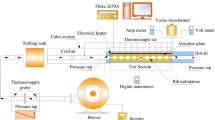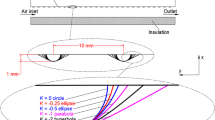Abstract
In this paper a new concept via the use of flexible ribs to control flow and heat transfer inside the air duct of a solar air collector is proposed. The new model uses flexible ribs instead of conventional fixed ribs, to improve the control efficiency and, therefore, to seek better energy extraction performance. The effect of flow mass rates on flow and heat transfer behavior has been investigated. It is apparent that the turbulence generated by flexible ribs provides a greater increase in heat transfer over the air duct. Results show also that the thermal enhancement factor tends to increase with the rise of Reynolds number where the highest value of this factor is registered for the flexible ribs configuration.















Similar content being viewed by others

Abbreviations
- a max :
-
Oscillating amplitude (m)
- D h :
-
Hydraulic diameter H (m)
- D :
-
Drag force (N)
- e :
-
Ribs thickness (m)
- f flexion :
-
Oscillating frequency (Hz)
- f :
-
Friction factor
- H :
-
Channel height (m)
- h :
-
Flexible ribs length (m)
- h c :
-
Convective heat transfer coefficient W m−2 K−1
- h(x):
-
Instantaneous ribs position along the x-axis
- h(y):
-
Instantaneous ribs position along the y-axis
- k :
-
Thermal conductivity W m−1 K−1
- L :
-
Solar collector length (m)
- m:
-
Mass flow rate
- Nu :
-
Nusselt number
- P :
-
Spacing between ribs (m)
- Re :
-
Reynolds number (\(\rho \overline{U} D_{h} /\mu\))
- T :
-
Temperature (K)
- t :
-
Instant time (s)
- U :
-
Incoming flow velocity (m s−1)
- \(\overline{U}\) :
-
Mean velocity in channel (m s−1)
- η :
-
Thermal enhancement factor = ((Nu/Nu 0)/(f/f 0))1/3
- μ :
-
Dynamic viscosity
- ρ :
-
Density
References
Prasad K, Mullick SC (1983) Heat transfer characteristics of a solar air heater used for drying purposes. Appl Energy 13(2):83–93
Karwa R, Solanki SC, Saini JS (2001) Thermo-hydraulic performance of solar air heaters having integral chamfered rib roughness on absorber plates. Energy 26:161–176
Saini RP, Verma J (2008) Heat transfer and friction factor correlations for a duct having dimple-shaped artificial roughness for solar air heaters. Energy 33:1277–1287
Singh S, Chander S, Saini JS (2011) Heat transfer and friction factor correlations of solar air heater ducts artificially roughened with discrete V-down ribs. Energy 36:5053–5064
Kumar A, Bhagoria JL, Sarviya RM (2009) Heat transfer and friction correlations for artificially roughened solar air heater duct with discrete W-shaped ribs. Energy Convers Manag 50:2106–2117
Kumar S, Saini RP (2009) CFD based performance analysis of a solar air heater duct provided with artificial roughness. Renewable Energy 34:1285–1291
Gandhi BK, Singh KM (2010) Experimental and numerical investigations on flow through wedge shape rib roughened duct. Inst Eng (India) J MC 90:13–18
Yadav AS, Bhagoria JL (2013) A CFD (computational fluid dynamics) based heat transfer and fluid flow analysis of a solar air heater provided with circular transverse wire rib roughness on the absorber plate. Energy 55:1127–1142
Bekele A, Mishra M, Dutta A (2013) Heat transfer augmentation in solar air heater using delta-shaped obstacle mounted on the absorber plate. Int J Sustain Energy 32(1):53–69
Shih T, Liou W, Shabbir A, Yang Z, Zhu J (1995) A new k–ε eddy viscosity model for high Reynolds number turbulent flows. Comput Fluids 24(3):227–238
Muneer T, Maubleu S, Asif M (2004) Renewable and sustainable energy reviews. Prospects Sol Water Heat Text Ind Pak 10:1–23
Mahfoud O, Moummi A, Kadja M, Moummi N, Mebrouk R (2013) Dynamic and thermal study of air flow control by ribs with inclined upper parts in solar air collectors. Int J Sustain Energy. doi:10.1080/14786451.2013.821125
Turek S, Hron J (2006) Proposal for numerical benchmarking of fluid structure interaction between an elastic object and laminar incompressible flow. In: Bungartz H-J, Schäfer M (eds) Fluid–structure interaction: modelling, simulation, optimisation, LNCSE. Springer, Berlin
Menasria F, Moummi A, Moummi N, Zedayria M, Guestel M (2011) Modélisation des échanges convectifs dans le conduit utile d’un capteur solaire plan à air muni de rugosités artificielles de formes rectangulaires. Rev Energies Renouv 14(3):369–379
Author information
Authors and Affiliations
Corresponding author
Additional information
Technical Editor: Jose A. dos Reis Parise.
Rights and permissions
About this article
Cite this article
Bouzaher, M.T., Baissi, M.T. & abdelbasset, C. CFD analysis of solar air collector equipped with flexible ribs. J Braz. Soc. Mech. Sci. Eng. 38, 2289–2297 (2016). https://doi.org/10.1007/s40430-016-0500-3
Received:
Accepted:
Published:
Issue Date:
DOI: https://doi.org/10.1007/s40430-016-0500-3



